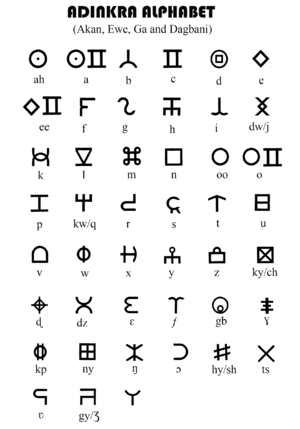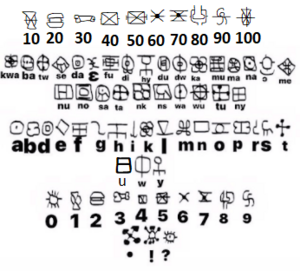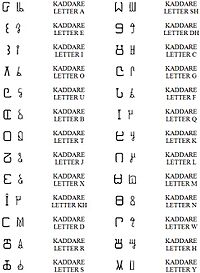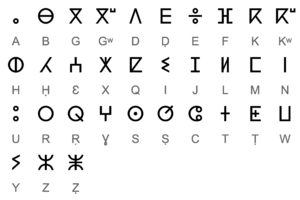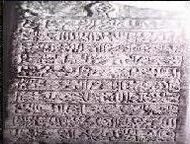Writing systems of Africa facts for kids
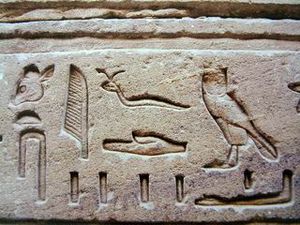
Africa has a rich history of writing systems. These are ways people record information using symbols or letters. Some writing systems were created in Africa, while others came from different parts of the world. For a long time, many African societies passed down their history and stories through spoken words, known as oral tradition. Even so, many groups also developed their own unique ways of writing.
Today, you will see the Latin script (like the one you are reading now) used a lot in West, Central, and Southern Africa. The Arabic script is common in North Africa. The Ge'ez script is widely used in the Horn of Africa. Other scripts are also very important in specific regions.
Some of the oldest writing in the world comes from North Africa. However, many writing systems in Subsaharan Africa were developed more recently. This does not mean there was no writing there before modern times. For example, the Tifinagh script has been used by the Tuareg people for a very long time. The Geʽez script has also been used in the Horn of Africa for centuries. Other groups learned about Latin and Arabic scripts but did not widely use them until the 1800s.
African Writing Systems
Ancient African Scripts
Africa is home to some of the world's oldest and most interesting writing systems. These ancient scripts tell us a lot about the people who created them.
Ancient Egyptian Hieroglyphs

Perhaps the most famous African writing system is ancient Egyptian hieroglyphs. These beautiful symbols developed into simpler forms called Hieratic and Demotic. Later, with influences from Phoenician and Greek, they led to the Coptic alphabet. The Coptic language is still used today in churches in Egypt.
Ancient Meroitic Script
The Meroitic alphabet was used in the ancient Kingdom of Kush (which is now Sudan). People wrote in Meroitic from about 300 BCE to 400 CE.
Tifinagh Script
The Tifinagh alphabet is still used today by Berber people in North Africa and the Sahara Desert. It is used for languages like Tamazight and Tamashek. A newer version, called Neo-Tifinagh, is used more widely.
Ge'ez Script
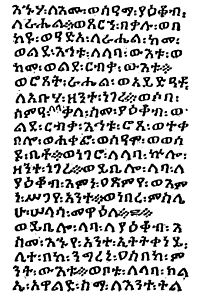
The Geʽez script was created in the Horn of Africa around the 8th or 9th century BC. It was first used for the Geʽez language. Today, it is used in Ethiopia and Eritrea for languages like Amharic and Tigrinya. People in these countries sometimes call it fidel or abugida.
Nsibidi Symbols
Nsibidi is a system of symbols from southeastern Nigeria. It seems to be a way of writing ideas, though some think it also includes symbols for words. These symbols are very old. Early forms have been found on pottery dating back to 400 CE, and possibly even earlier.
Adinkra Symbols
Adinkra are symbols created by the Akan people of Ghana and Côte d'Ivoire. They represent ideas and wise sayings. These symbols helped pass down important traditions and beliefs.
Over time, Adinkra symbols have been adapted into writing systems. For example, the Adinkra Alphabet was invented in 2015 to write various Ghanaian languages. Another system, Adinkra Nkyea, is also used for the Akan Language.
Lusona Ideograms
Lusona is a system of pictures that helped people remember proverbs, stories, games, and riddles. They were used to share knowledge in areas that are now eastern Angola, northwestern Zambia, and parts of the Democratic Republic of the Congo.
Modern African Scripts
Many new writing systems have been developed in Africa in recent times. Some are still used today, while others have been replaced by Latin or Arabic scripts.
East African Scripts
- The Luo script was created in 2009 to write the Dholuo language in Kenya.
- In Somalia, new writing systems for the Somali language were invented in the 20th century. These include the Osmanya, Gadabuursi, and Kaddare alphabets.
- An alphabet for the Oromo language in Ethiopia was invented in the 1950s by Sheikh Bakri Sapalo.
- A script called Nilerian was invented for the Dinka language and other languages in South Sudan.
Southern African Scripts
- The Mwangwego alphabet is used to write Malawian languages in Southern Africa.
- IsiBheqe SoHlamvu, also known as Ditema tsa Dinoko, is a special type of writing system used for Southern Bantu languages.
Central African Scripts
- The Bamum script was developed by Sultan Ibrahim Njoya in Cameroon. It is a system where each symbol represents a syllable.
- The Eghap script was used by the Bagam people of Cameroon.
- The Mandombe script was invented in 1978 in the Democratic Republic of the Congo. It is used for languages like Kikongo, Lingala, and Swahili.
- The Zaghawa alphabet was developed for the Zaghawa language in Darfur and Chad.
West African Scripts
West Africa has seen many new writing systems created in the last two centuries.
- The Adlam script was developed for the Fula language. It is taught in Guinea and other nearby countries.
- The Ba script and Dita are also used to write Fula.
- The Bassa alphabet is from Liberia.
- The Bété syllabary is from Ivory Coast.
- The Garay alphabet is used for Wolof and Mandinka in Senegal and The Gambia.
- The Gbékoun script is for the Fon language in Benin.
- The Gola Script is for Liberia and eastern Sierra Leone.
- The Goulsse alphabet is for Gur languages.
- Several scripts exist for the Hausa language.
- Koré Sèbèli was developed in 2009 for the Susu language of Guinea and Sierra Leone.
- The Kpelle syllabary is from Liberia and Guinea.
- The Loma syllabary is also from Liberia and Guinea.
- Masaba is a syllabary invented in the 1930s for the Bambara language of Mali.
- Medefaidrin is used by the Obɛri Ɔkaimɛ Church for the Ibibio people.
- The Mende Ki-ka-ku syllabary was invented in Sierra Leone in the early 20th century and is still used.
- Ńdébé was developed between 2009 and 2020 for the Igbo language of Nigeria.
- The N'Ko script was invented in 1949 in Guinea for the Manding languages. It is becoming more popular in West Africa.
- The Nwagu Aneke script was invented in the 1950s for the Igbo language.
- The Oduduwa script was invented in 2016-2017 for the Yoruba language.
- The Vai syllabary was invented in Liberia in the early 19th century and is still used today.
- Yoruba Holy Writing is used for texts of the Yoruba religion.
Tifinagh in North Africa
Tifinagh is a script used to write the Berber languages. It comes from an older alphabet called Libyco-Berber. The traditional Tifinagh is still used by the Tuareg people in the Sahara Desert. A newer version, called Neo-Tifinagh, was created to be used across North Africa.
Writing Systems from Other Places
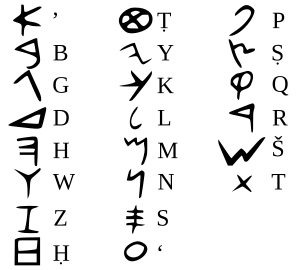
Many writing systems around the world, including Greek, Hebrew, and Arabic, were built upon older scripts. The very first alphabet likely came from ancient Egyptian Hieroglyphs. Similarly, many African scripts also developed from earlier ones.
Phoenician and Punic Scripts
The Phoenicians, from what is now Lebanon, traded with North Africans and founded cities like Carthage. The Phoenician alphabet is believed to be the origin of many other alphabets, including Arabic, Greek, and Latin. The Punic language was a dialect spoken in Carthage. Some scholars think that today's Tifinagh script might have come from Punic, but this is still being discussed.
Greek Script
The Greek alphabet was adapted in Egypt to create the Coptic alphabet. Seven new letters were added from ancient Demotic to write the Coptic language. This language is now mainly used in the Coptic Church. An old version of the Coptic alphabet was also used to write Old Nubian from the 8th to the 15th century.
Arabic Script
The Arabic script came to Africa with the spread of Islam and through trade. Besides being used for the Arabic language, it was adapted for many other African languages over the centuries. This adapted form is often called Ajami, especially in the Sahel region. Sometimes it has specific names, like Wolofal or Sorabe. Even in Ethiopia and Eritrea, where Ge'ez is common, some Muslims use the Arabic script for religious reasons.
Latin Script
The Latin Script was used in Roman North Africa. Later, Christian missionaries began to adapt it for African languages before European colonization. This was challenging because many African languages have sounds not found in European languages. To represent these sounds, people used different letter combinations or special marks. Some of these writing systems, like the Yoruba writing system, are still used today.
Colonial governments sometimes helped decide how African languages should be written using the Latin script. After countries gained independence, there were efforts to create standard ways of using the Latin script for African languages. Examples include the Lepsius Standard Alphabet and the Africa Alphabet. The African Reference Alphabet was also created in 1978 to help standardize writing across different languages.
Hebrew Script
Jewish communities have lived in North Africa for thousands of years. Many of their languages, like Haketia and some forms of Judeo-Arabic, have been written using the Hebrew alphabet.
Braille
Braille is a system of raised dots that visually impaired people use to read and write. It has been adapted for many African languages, including those in Nigeria, South Africa, and Zambia.
Writing and Computers
Early Computer Use
In the early days of computers, people found ways to adapt existing fonts to include special characters needed for African languages. This was done in many different ways, so fonts were not always compatible. For the Geez script, used in Ethiopia and Eritrea, the first computer output was developed in 1983.
Modern Standards
Today, Unicode helps solve the problem of incompatible character encoding. This means that characters from different languages can be used on computers without issues. Many African scripts, including Osmanya, Tifinagh, Bamum, Adlam, Bassa Vah, Medefaidrin, and N'Ko, have been added to Unicode. Efforts are ongoing to add even more African scripts, including ancient ones like Egyptian hieroglyphs.


